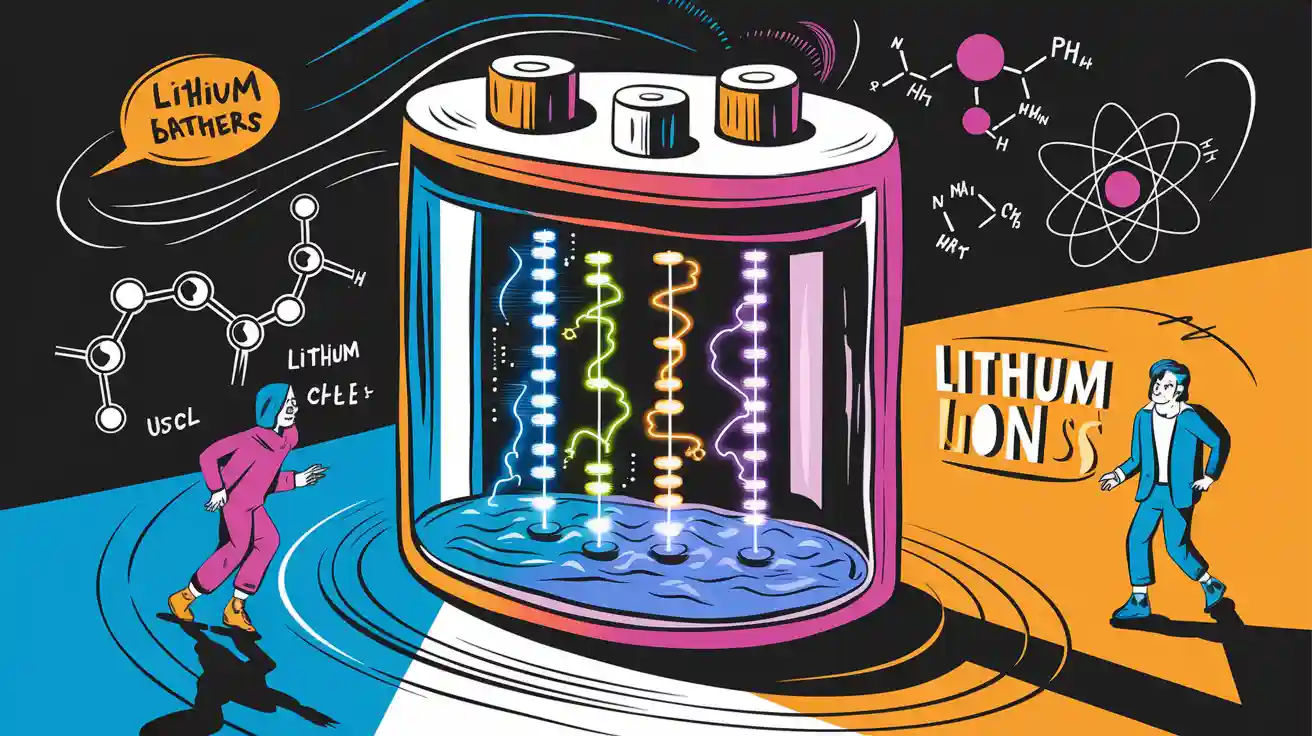
Lithium salts in battery electrolytes play a pivotal role in enabling efficient energy transfer and maintaining stability during operation. These compounds ensure ionic conductivity, allowing lithium ions to move seamlessly between electrodes. Data from over 13,000 experiments reveals their performance across 38 solvents and 14 lithium salts, highlighting their adaptability under diverse conditions. By optimizing lithium salts, you can enhance energy density and cycle life, ensuring your lithium-ion batteries meet industrial demands.
Key Takeaways
Lithium salts are important for moving energy in batteries. They help lithium ions travel between parts of the battery, which is key for it to work well.
Picking the right lithium salt can make batteries last longer. For instance, LiFSI works well and stays stable in heat, so it’s great for powerful uses.
Being eco-friendly is important when making lithium salts. Choose companies that care about the planet and think about recycling to help the environment.
Part 1: Basics of Battery Electrolytes and Lithium Salts

1.1 Definition and Function of Battery Electrolytes
Battery electrolytes act as the medium for ion conduction within lithium-ion batteries. These liquid or gel substances dissolve lithium salts, enabling the movement of lithium ions between electrodes during charging and discharging. The electrolyte also includes additives to improve conductivity, stability, and safety. Without a functional battery electrolyte, energy transfer would halt, rendering the battery ineffective.
1.2 Importance of Lithium Salts in Battery Electrolytes
Lithium salts are indispensable for the operation of lithium-ion batteries. They ensure the seamless movement of lithium ions, which is critical for energy transfer. Their role extends beyond conduction, as they stabilize the battery’s thermal and chemical environment.
Key Contributions of Lithium Salts:
Facilitate lithium-ion migration between electrodes.
Form a solid electrolyte interface (SEI) layer to prevent side reactions.
Enhance cycle life, charging speed, and energy density.
LiPF₆, a widely used lithium salt, exemplifies these benefits. It offers high ionic conductivity, forms a stable SEI layer, and dissolves effectively in organic solvents. These properties make it suitable for industrial applications, including robotics and consumer electronics.
1.3 Common Lithium Salts Used in Lithium Battery Electrolytes
Recent studies highlight the comparative advantages of various lithium salts. The table below summarizes their strengths and weaknesses:
Lithium Salt | Advantages | Disadvantages |
|---|---|---|
LiPF₆ | High ionic conductivity, stable SEI layer | Poor thermal stability |
LiBF₄ | Wide temperature range | Low ionic conductivity |
LiFSI | High conductivity, low water sensitivity | Corrosion potential of Al foil |
LiTFSI | High solubility, thermal stability | Corrodes Al current collector |
Selecting the right lithium salt depends on your application. For example, LiFSI suits high-performance batteries due to its conductivity and stability, while LiBF₄ excels in extreme temperatures.
For custom battery solutions tailored to your needs, explore Large Power’s offerings.
Part 2: Role of Lithium Salts in Battery Electrolytes

2.1 Facilitating Ion Conduction and Energy Transfer
Lithium salts serve as the backbone of ion conduction in lithium battery electrolytes. When dissolved in an electrolyte, these salts dissociate into lithium ions and counterions. The charged lithium ions migrate between the anode and cathode during charging and discharging, enabling energy transfer. This movement is crucial for maintaining the functionality of lithium batteries across various applications, including robotics and consumer electronics.
The role of lithium salts in ensuring conductivity cannot be overstated. For instance, LiPF₆, a widely used lithium salt, exhibits high ionic conductivity, making it ideal for industrial-grade lithium-ion batteries. The solvent composition in the electrolyte also influences transport properties. Studies show that variations in these properties can result in a polarization difference of approximately 40 mV at 0.8 state of discharge (SOD) and 90% state of health (SOH). By optimizing the combination of lithium salts and solvents, you can achieve more efficient ion conduction and extend battery life.
Tip: Selecting the right lithium salt for your battery electrolyte ensures stable battery performance and minimizes energy loss during operation.
2.2 Enhancing Electrochemical Stability and Longevity
The electrochemical stability of lithium salts directly impacts the longevity of lithium batteries. A stable electrolyte environment prevents unwanted side reactions, which can degrade battery components over time. Lithium salts like LiPF₆ and LiFSI play a pivotal role in forming a solid electrolyte interface (SEI) layer on the anode. This layer acts as a protective barrier, reducing electrolyte decomposition and enhancing the battery’s cycle life.
For high-voltage applications, the choice of lithium salt becomes even more critical. LiFSI, for example, offers superior thermal and chemical stability, making it suitable for advanced battery systems. According to predictive models, accounting for changes in transport properties can add approximately 200 additional cycles before the battery reaches 90% SOH. This improvement underscores the importance of selecting lithium salts that align with your battery’s operational requirements.
2.3 Impact on Energy Density and Power Output
Lithium salts significantly influence the energy density and power output of lithium batteries. High energy density is essential for applications requiring compact and lightweight designs, such as medical devices and consumer electronics. Lithium salts like LiPF₆ and LiTFSI enable high ionic conductivity, which supports faster charging and discharging rates. This capability translates to improved power output and efficiency.
The role of electrolyte composition also extends to energy density optimization. For example, LiPF₆-based electrolytes are commonly used in NMC lithium batteries, which offer an energy density range of 160–270 Wh/kg. These batteries balance high energy density with a cycle life of 1,000–2,000 cycles, making them ideal for industrial and infrastructure applications. By tailoring the electrolyte formulation, you can maximize the performance of your lithium-ion batteries while meeting specific energy and power demands.
Note: To explore custom battery solutions that optimize energy density and power output, visit Large Power’s offerings.
Part 3: Safety and Environmental Considerations for Lithium Battery Electrolytes

3.1 Thermal Stability and Risk Mitigation
Thermal stability is a critical factor in ensuring battery safety. Lithium salts play a pivotal role in maintaining the thermal stability of the electrolyte, which directly impacts the overall safety of lithium-ion batteries. High temperatures can cause the electrolyte to decompose, leading to gas generation, swelling, or even thermal runaway. Selecting lithium salts with high thermal stability, such as LiFSI, can significantly reduce these risks.
To further enhance safety, manufacturers have adopted advanced designs, such as safety-reinforced layers (SRLs) in battery cells. These layers act as thermal barriers, preventing heat propagation and reducing the likelihood of catastrophic failures. For instance, impact testing on 3.4-Ah pouch cells demonstrated a reduction in battery explosions from 63% to 10% after implementing SRLs. This highlights the importance of integrating both material and structural innovations to mitigate risks.
Tip: When designing batteries for high-temperature environments, prioritize lithium salts with superior thermal stability and consider incorporating safety-enhancing features like SRLs.
3.2 Environmental Impact and Toxicity of Lithium Salts
The environmental footprint of lithium salts extends beyond their use in batteries. The extraction and processing of lithium contribute to significant ecological challenges. Lithium mining often involves water diversion and the use of chemicals like sulfuric acid and sodium hydroxide, which can poison ecosystems and threaten local wildlife. In Chile, for example, lithium mining has been linked to the endangerment of two flamingo species.
The carbon emissions from lithium mining also exacerbate climate change. A 2019 study by The Wall Street Journal revealed that 40% of the total climate impact from lithium-ion battery production stems from the mining process. This underscores the need for more sustainable practices in the production of lithium salts.
Environmental Challenges | Impact |
|---|---|
Water diversion | Depletes local water resources |
Soil contamination | Reduces agricultural productivity |
Toxic chemical use | Harms ecosystems and wildlife |
Carbon emissions | Accelerates climate change |
To address these issues, you should consider sourcing lithium salts from suppliers committed to sustainable practices. Additionally, recycling and reusing lithium from spent batteries can help reduce the demand for new mining operations.
Note: Learn more about sustainability initiatives in the battery industry here.
3.3 Development of Safer and Sustainable Lithium Salts
The development of safer and more sustainable lithium salts is a growing focus in the battery industry. Researchers are exploring alternatives to traditional salts like LiPF₆, which, despite its widespread use, has limitations in thermal stability and environmental impact. New-generation salts, such as LiFSI and LiTFSI, offer improved performance and reduced toxicity.
Key trends in the development of lithium salts include:
High-voltage compatibility: Advanced salts like LiFSI support high-voltage cathodes, enabling higher energy densities.
Reduced environmental impact: Efforts are underway to develop salts with lower ecological footprints, including those derived from renewable resources.
Enhanced recyclability: Salts designed for easier recovery during battery recycling processes are gaining traction.
These innovations not only improve battery performance but also align with global sustainability goals. By adopting these advanced materials, you can contribute to a more sustainable energy ecosystem while meeting the growing demand for high-performance batteries.
Call to Action: For custom battery solutions that prioritize safety and sustainability, explore Large Power’s offerings.
Part 4: Future Trends in Lithium Salts for Battery Electrolytes

4.1 Innovations in Lithium Salt Formulations
The development of lithium salts continues to evolve, driven by the need for safer, more efficient, and sustainable battery technologies. Researchers are exploring innovative formulations to address challenges like thermal stability, energy density, and environmental impact. Emerging trends in this field highlight the industry’s focus on performance and sustainability.
Trend | Description |
|---|---|
Development of high-energy density electrolytes | Enhancing battery energy density and lifespan to meet growing demands. |
Focus on solid-state electrolytes | Promising candidates for future batteries due to improved safety and performance. |
Increased emphasis on sustainability | Movement towards eco-friendly and sustainable electrolyte formulations and manufacturing processes. |
Advancements in electrolyte recycling | Innovations aimed at creating a circular economy for battery materials. |
Recent breakthroughs include the transition from flammable liquid electrolytes to safer alternatives like “water-in-salt” (WiS) and “water-in-bisalt” (WiBS) formulations. These polymer-based electrolytes improve safety and performance, offering better stability and longer battery lifecycles. By adopting these advancements, you can achieve higher efficiency and reliability in your battery systems.
Tip: Consider integrating cutting-edge lithium salt formulations to future-proof your battery designs and align with sustainability goals.
4.2 Advancements for High-Voltage Battery Systems
Advancements in lithium salt technology are paving the way for high-voltage battery systems with superior performance. These innovations enhance energy density, safety, and charging efficiency, making them ideal for applications requiring high power output. Solid-state electrolytes, combined with new cathode materials, are key to overcoming current limitations in high-voltage systems.
Lithium salts like LiFSI and LiTFSI are particularly effective in supporting high-voltage cathodes. Their thermal and chemical stability ensures consistent performance under demanding conditions. For instance, batteries utilizing these salts can achieve higher energy densities without compromising safety. This makes them suitable for electric vehicles, grid storage, and other high-performance applications.
By leveraging these advancements, you can unlock the full potential of high-voltage battery systems, ensuring they meet the growing demands of modern energy storage solutions.
Note: Stay ahead of the curve by adopting lithium salts optimized for high-voltage applications to enhance both performance and safety.
Lithium salts remain indispensable for the performance, safety, and efficiency of lithium-ion batteries. Their ability to facilitate ion conduction, stabilize electrochemical environments, and enhance energy density makes them a cornerstone of modern energy storage systems.
Key Insight: Addressing challenges like thermal stability and environmental impact is essential for sustainable battery solutions. By adopting advanced lithium salts, you can improve safety and align with global sustainability goals.
Future innovations in lithium salt formulations will drive progress in battery technology, supporting the global shift toward renewable energy. To explore custom battery solutions tailored to your needs, visit Large Power.
FAQ
1. What is the primary role of lithium salts in battery electrolytes?
Lithium salts enable lithium-ion conduction between electrodes, ensuring efficient energy transfer. They also stabilize the electrolyte environment, enhancing battery performance and longevity.
2. How do lithium salts impact battery safety?
Lithium salts with high thermal stability reduce risks like thermal runaway. Choosing advanced salts like LiFSI improves safety in high-temperature applications.
3. Are lithium salts environmentally sustainable?
Traditional lithium salts pose environmental challenges. New-generation salts focus on reduced toxicity, recyclability, and eco-friendly production methods to align with sustainability goals.




